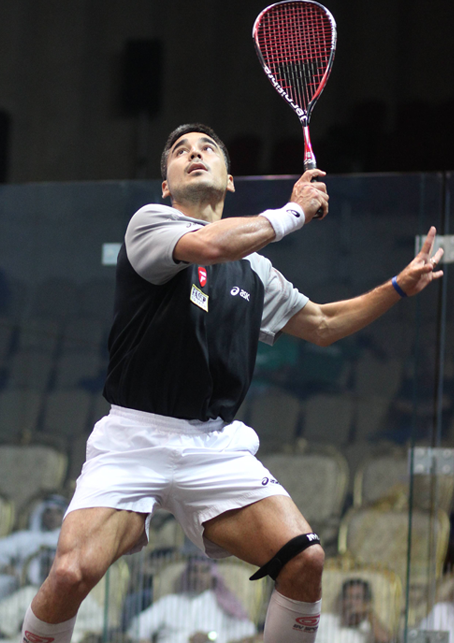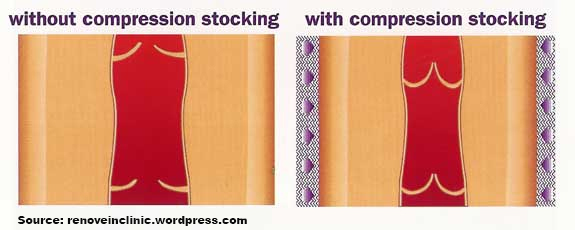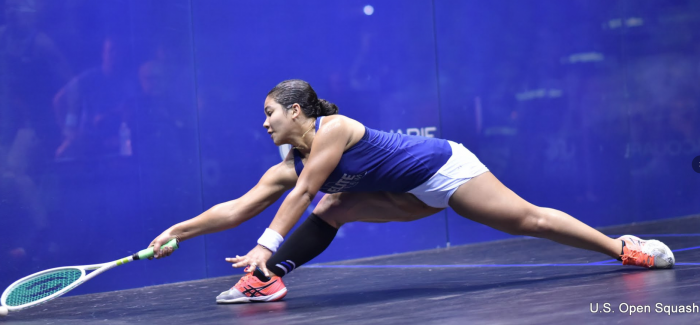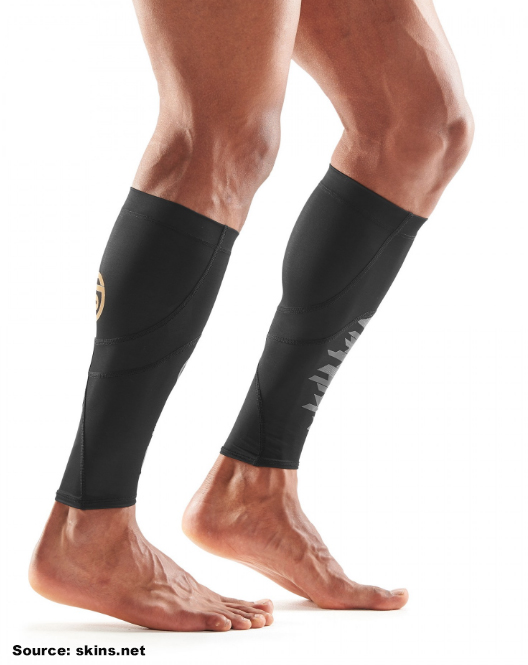There are always an interesting variety of ‘performance enhancement’ tools, supplements, and interventions being utilised/promoted by top level athletes, some with more scientific plausibility behind them than others. These tend to vary in popularity, some being mere fleeting trends that are gone and replaced by some other fad in short order, while others can often stick around a lot longer.
One of the more popular of the proposed performance enhancers that have been around and maintained quite a high profile for a number of years now are Compression Garments. They’re obviously a big part of many athletes training and matchplay equipment, but do they actually have any tangible positive benefits for the squash player?
 Some proposed performance enhancers tend to take hold and become associated with a certain sport, such as Kinesio taping with athletics and swimming. Recently it’s been compressive garments, particularly the compression socks/calf sleeves, that have become particularly visible in squash even as compared to other sports, with former squash world number 1 Thierry Lincou one of the first elite sportspersons to be seen regularly wearing them. His countryman Gregory Gaultier is perhaps the most high profile player to be seen frequently wearing them in recent times, but a number of other PSA pros are also advocates, and this popularity has even trickled down to the club/recreation level now as well
Some proposed performance enhancers tend to take hold and become associated with a certain sport, such as Kinesio taping with athletics and swimming. Recently it’s been compressive garments, particularly the compression socks/calf sleeves, that have become particularly visible in squash even as compared to other sports, with former squash world number 1 Thierry Lincou one of the first elite sportspersons to be seen regularly wearing them. His countryman Gregory Gaultier is perhaps the most high profile player to be seen frequently wearing them in recent times, but a number of other PSA pros are also advocates, and this popularity has even trickled down to the club/recreation level now as well
As with many such sporting products, for a lot of players, it is pretty much just a ‘fashion item’ for them. You ask most players why they wear them, and they’ll mumble something about ‘helping their muscles work better’, or ‘stopping them cramping up’. Compression garments have actually been around for over 50yrs now however, with quite specific reasons for their original development and implementation.
While compression garments take the form of everything from arm sleeves to undershorts nowadays, it was compression stockings that were actually first implemented and popularised within a medical setting. Medical compression stockings were originally used to help maintain venous blood flow, and are still used today in the treatment of conditions such as varicose veins and deep vein thrombosis (DVT), and also frequently used as part of pre and post-surgery treatments.
 They work by putting pressure on the blood vessels in your leg, compressing these and the surrounding tissues, which is said to increase the speed at which blood travels through them and flows back to the heart. These stockings are usually ‘graduated’, in that the pressure is greatest at the ankle and reduces further up toward the knees/thighs (depending on the particular length worn).
They work by putting pressure on the blood vessels in your leg, compressing these and the surrounding tissues, which is said to increase the speed at which blood travels through them and flows back to the heart. These stockings are usually ‘graduated’, in that the pressure is greatest at the ankle and reduces further up toward the knees/thighs (depending on the particular length worn).
So how have compression garments been taken on by the sports performance world?
Never ones to miss out on launching a good sales pitch, many sporting goods companies now produce their own variations of compression clothing, with a variety of shorts/tights/tops being available, along with all manner of vague extrapolated promises of increased performance and associated technologies. The primary proposed benefits still stem back to the basic increased blood flow demonstrated from their medical compression stocking origins, but further benefits have now also been suggested based mainly around the compressive properties of reducing muscle/soft tissue swelling, and of helping prevent ‘muscle oscillation’.
A number of studies have been done into what – if any – performance-enhancing effects the compression garments actually have, and results have been rather mixed and generally less than inspiring. Certain manufacturers have made claims that the garments provide various ergogenic effects during a sporting activity, and may be able to increase both sprint/power output, and enhance endurance performance – both advantages that would be of great interest to the squash player.
The theorised mechanism of effect for these benefits includes both of the aforementioned increased blood flow and reduced muscle oscillation – the idea being that increased blood flow helps encourage transport of fresh oxygenated blood to the muscles and metabolite clearance, while the reduced muscle oscillation will result in decreased fatigue and increased efficiency from the muscles. Supportive scientific research into these suggested benefits however, has been limited.
While these proposed mechanisms of effect do actually have some plausibility, in practice the effect is probably too small to really have any significant reliable effect on performance for the average amateur squash player. While some studies have indeed shown certain strength/power/endurance improvements in certain situations from certain garments, these have been difficult to replicate and gain consistent clear positive results from. Part of the problem stems from the difficulty in actually designing a test that controls for the placebo effect (the possibility that any beneficial effects are psychological as opposed to physiological), which means there are a lot more studies of less robust design, as well as related issues of a significant researcher bias issue (a lot of studies are performed ‘in-house’ by the equipment manufacturers themselves).
Similar to something like acupuncture, it is very difficult to have a ‘sham’ compressive garment in a study – it will usually be quite obvious to an experiment participant that their garment either is or isn’t compressive, unlike say a study into a certain drug, where an inert sugar pill will look/feel/taste identical to an active medicine. In addition to all this, there are so many different variables to consider, including the type of garment, what body part it is worn upon, how long it’s worn for, the type of activity being performed, and the training level of the participants, that it is almost impossible to standardise any research.
So if the evidence for compressive garments enhancing athletic performance is sketchy and inconclusive, does this mean that they’re probably not worth using? Not necessarily. Where research HAS shown a little more in the way of encouraging results, is in the effect of compressive garments on recovery.

Exercise/training-induced muscle damage can consist of a variety of issues including a reduction in subsequent short-term performance, reduced force production, and increased inflammation and pain. It is suggested that compression garments can help control these negative effects by supporting the damaged/injured tissue, controlling swelling, and providing a degree of immobilisation. Putting on – or keeping on if worn during the session – compressive socks/shorts/tights immediately after heavy exercise has been shown in several studies to potentially decrease muscle soreness and perceived fatigue in those areas – both psychologically (participants reported feeling better), and physiologically (reduction in participants blood concentrations of certain markers of damage). This may also logically play a part in boosting subsequent performance if these soreness/fatigue indices are moderated.
It is important that the garments are worn for a prolonged period post-exercise to gain these benefits – anything from 24hr to 3 days has been proposed (or at least until your next match if participating in tournament competition or similar). It is also essential to ensure that the garment worn is tight enough – various amounts of compression have been tested and recommended, but the consensus appears to be around 18 – 25 mmHg of pressure for ankle/calf sleeves, and a little less further up on the thigh. This is tighter than many people realise and tighter than many companies actually produce, so it is important you get yourself sized correctly and buy accordingly.
 A lot of sportswear companies have simply jumped on the bandwagon and brought alleged ‘compression garments’ to market that are little more than standard lycra tights, including several of the more well-known sporting giants. The company I generally recommend for compression products is Skins, as their products are generally of much higher quality and fit, they participate in a lot of on-going research, and they were also one of the early pioneers of compressive garment technology. When I undertook a scientific research project into compression garments several years ago, Skins were also one of the only companies that offered up a look into their research and development programmes, the ‘big two’ sportswear companies, in particular, were conspicuous by their very vague responses to questions of their own independently undertaken research.
A lot of sportswear companies have simply jumped on the bandwagon and brought alleged ‘compression garments’ to market that are little more than standard lycra tights, including several of the more well-known sporting giants. The company I generally recommend for compression products is Skins, as their products are generally of much higher quality and fit, they participate in a lot of on-going research, and they were also one of the early pioneers of compressive garment technology. When I undertook a scientific research project into compression garments several years ago, Skins were also one of the only companies that offered up a look into their research and development programmes, the ‘big two’ sportswear companies, in particular, were conspicuous by their very vague responses to questions of their own independently undertaken research.
So are compressive garments worth wearing? Potentially, yes. While significant performance enhancements from wear during your games/training is unlikely, they almost certainly don’t cause any harm – indeed, many athletes like the comfort and secure fit provided by-products such as the compression shorts and socks in particular, and they may also play some small role in helping muscles ‘warm-up’ before training/competition.
Where the most benefit is likely however, is in wearing the garments AFTER strenuous activity (or wearing them during activity and then keeping them on afterwards), where both physiological and perceptive benefits in recovery from muscle damage and fatigue have been demonstrated. Wear during air travel has also shown benefits, particularly pertinent for travelling professionals.
Putting them on to play/train and then taking them off immediately after your session however, is unlikely to offer any real benefit – they may make you look and feel like Gregory Gaultier, but they are sadly pretty unlikely to help you move and play like him!
Gary Nisbet
B.Sc.(Hons), CSCS, NSCA-CPT, Dip. FTST
SquashSkills Fitness & Performance Director
Sign up to the SquashSkills newsletter
Get world class coaching tips, straight to your inbox!